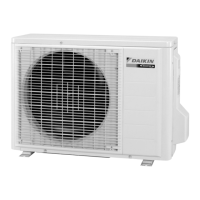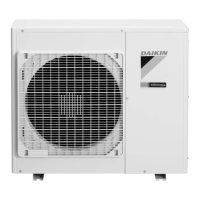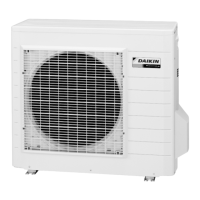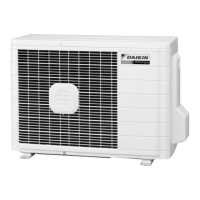Do you have a question about the Daikin RKS20G2V1B and is the answer not in the manual?
Lists functions applicable to cooling-only models, detailing features and model compatibility.
Lists functions applicable to cooling-only models, detailing features and model compatibility.
Lists functions applicable to heat pump models, detailing features and model compatibility.
Provides detailed technical specs for cooling-only indoor/outdoor units: capacity, power, dimensions.
Provides detailed technical specs for cooling-only indoor/outdoor units: capacity, power, dimensions.
Provides detailed technical specs for heat pump indoor/outdoor units: capacity, power, dimensions.
Details connectors on indoor unit PCBs: control, receiver, display, and sensor.
Details connectors on indoor unit PCBs: control, receiver, display, and sensor.
Details connectors on outdoor unit PCBs: filter and main units for various models.
Explains inverter principle for compressor speed and capacity regulation.
Explains inverter principle for compressor speed and capacity regulation.
Describes adjusting airflow direction using flaps and louvers for comfort.
Explains 9 fan speed steps and automatic control based on temperature.
Details dry mode for humidity removal while maintaining room temperature.
Explains automatic mode selection of cooling/heating based on room temperature.
Describes thermostat logic based on room vs. target temperature difference.
Explains temperature adjustment for sleep comfort and energy saving.
Describes operation limiting power consumption for energy efficiency.
Explains motion sensor for people detection, airflow adjustment, and energy saving.
Details sensor operation for presence detection and capacity adjustment.
Explains maximizing cooling/heating by increasing fan speed and compressor frequency.
Covers miscellaneous functions like Hot-Start, Signal Receiving, and Auto-restart.
Explains the role of thermistors in controlling operation based on temperature readings.
Outlines normal and forced operation modes for cooling and heat pump systems.
Outlines normal and forced operation modes for cooling and heat pump systems.
Details frequency determination based on temperature difference and control functions.
Explains preheating operation conditions and controls during startup.
Describes using discharge pipe temperature for compressor frequency limits.
Explains input current calculation for setting frequency upper limits.
Details frequency limitation to prevent indoor heat exchanger freezing.
Explains temperature limits to prevent high pressure during heating.
Describes outdoor fan operation modes, speed, and delay functions.
Explains compressor stopping conditions based on temperature.
Details defrost process using the cooling cycle to remove frost.
Covers electronic expansion valve control for various operations and conditions.
Lists and explains malfunctions: sensor errors, overcurrent, refrigerant shortage.
Describes the forced cooling operation mode.
Explains enabling standby saving by turning off the outdoor unit.
Guidance on operating and handling the air conditioner post-installation.
Explains remote control buttons and functions for FTXS models.
Explains remote control buttons and functions for FTXS models.
Details starting, stopping, and setting modes: Auto, Dry, Cool, Heat, Fan.
Guides on adjusting horizontal and vertical airflow for comfort.
Explains Comfort Airflow and Intelligent Eye for optimized airflow and energy saving.
Describes maximizing cooling/heating for quick temperature adjustment.
Explains lowering outdoor unit noise by adjusting fan speed and frequency.
Details operation limiting power consumption for energy efficiency.
Explains setting OFF Timer and ON Timer for automatic control.
Describes setting up to 4 daily timer settings for automated schedules.
Explains remote control buttons and functions for ATXS models.
Explains remote control buttons and functions for ATXS models.
Details starting, stopping, and setting modes: Auto, Dry, Cool, Heat, Fan.
Guides on adjusting horizontal and vertical airflow for comfort.
Explains airflow direction adjustments for comfort during cooling and heating.
Details sensor operation for presence detection and airflow adjustment.
Explains maximizing cooling/heating for quick temperature adjustment.
Explains lowering outdoor unit noise by adjusting fan speed and frequency.
Details operation limiting power consumption for energy efficiency.
Explains setting OFF Timer and ON Timer for automatic control.
Guides troubleshooting indoor/outdoor unit errors indicated by LED blinking.
Guides troubleshooting indoor/outdoor unit errors indicated by LED blinking.
Lists common operational problems and their corresponding checks/measures.
Explains service checks using the ARC452 remote control.
Explains service checks using the ARC452 remote control.
Explains service checks using the ARC433 remote control.
Lists error codes and their descriptions for remote control display.
Lists error codes and their descriptions for remote control display.
Details troubleshooting steps for indoor unit PCB issues: checks and replacements.
Explains troubleshooting for freeze-up protection and heating peak-cut controls.
Guides troubleshooting fan motor issues and abnormalities.
Details troubleshooting for indoor unit thermistor abnormalities.
Provides troubleshooting for signal transmission errors between units.
Guides troubleshooting unspecified voltage issues between units.
Details troubleshooting steps for outdoor unit PCB issues: checks and replacements.
Explains troubleshooting for compressor overload (OL activation) errors.
Details troubleshooting steps for compressor lock errors.
Guides troubleshooting DC fan lock errors.
Explains troubleshooting for input overcurrent detection errors.
Details troubleshooting steps for four-way valve abnormalities.
Explains troubleshooting discharge pipe temperature control issues.
Guides troubleshooting high pressure control in cooling.
Details troubleshooting for compressor system sensor abnormalities.
Explains troubleshooting for position sensor abnormalities.
Guides troubleshooting DC voltage/current sensor issues for specific classes.
Details troubleshooting for CT or related abnormalities for the 50 class.
Explains troubleshooting for outdoor unit thermistor abnormalities.
Guides troubleshooting electrical box temperature rise.
Details troubleshooting for radiation fin temperature rise.
Explains troubleshooting for output overcurrent detection.
Guides troubleshooting refrigerant shortage detection methods.
Details troubleshooting for low-voltage or over-voltage detection.
Explains troubleshooting for signal transmission errors on the outdoor PCB.
Provides steps for checking various components and systems.
Steps for checking various components and systems.
Steps to check fan motor connector output for voltage and pulse signals.
How to check EV connection, sound, and continuity.
Checks for four-way valve performance: voltage, continuity, resistance.
Measures thermistor resistance against temperature charts.
Checks installation environment, airflow, and temperature conditions.
Checks discharge pressure, stop valve status, and pipe condition.
Checks outdoor fan motor and its running condition.
Checks power supply waveforms for sine wave and zero-cross disturbance.
Checks refrigerant system: thermistor disconnection, leakage.
Checks main circuit for shorts and measures capacitor voltage.
Measures resistance between diode bridge and compressor terminals.
Checks outdoor fan motor rotation pulse output and command voltage.
Measures resistance to detect main circuit short circuits.
Step-by-step guide for removing the air filter from the indoor unit.
Step-by-step guide for removing the air filter from the indoor unit.
Procedure for removing the indoor unit's front panel.
Steps to remove the indoor unit's front grille.
Instructions for removing horizontal and vertical airflow blades.
Procedure for removing the indoor unit's electrical box.
Steps to remove shield plate, terminal board, signal receiver, and control PCBs.
Steps for disconnecting piping and removing the indoor heat exchanger.
Guides on removing swing motors for vertical and horizontal blades.
Procedure for removing the indoor fan motor and rotor.
Steps to remove outer panels, stop valve cover, top panel, discharge grille, front panel.
Steps to remove outer panels, stop valve cover, top panel, discharge grille, front panel.
Procedure for disconnecting connectors and removing the electrical box.
Guides for releasing and removing thermistors.
Steps to remove the main PCB: disconnect connectors, screws.
Procedure for removing the reactor and partition plate.
Steps to remove sound blankets (outer, top, inner).
Guides on removing the four-way valve coil.
Procedure for removing the compressor: heating brazed parts, disconnecting.
Steps to remove outer panels, stop valve cover, top panel, discharge grille, front panel.
Steps to remove outer panels, stop valve cover, top panel, discharge grille, front panel.
Procedure for disconnecting connectors and removing the electrical box.
Steps to remove the main PCB: disconnect connectors, screws.
Procedure for removing the reactor and partition plate.
Steps to remove sound blankets (top upper, top lower, inner).
Guides on removing the four-way valve coil.
Procedure for removing the compressor: heating brazed parts, disconnecting.
Steps to remove outer panels, top panel, discharge grille, front panel.
Steps to remove outer panels, top panel, discharge grille, front panel.
Procedure for disconnecting connectors and removing the electrical box.
Steps to remove the PCB, including detaching insulation, terminals, harnesses.
Steps to remove sound blankets (partition plate, outer, top upper, top lower, inner).
Guides on removing outdoor fan, fan motor, and fixing frame.
Procedure for releasing and removing thermistors.
Steps to remove the four-way valve coil and electronic expansion valve.
Procedure for removing the compressor: disconnecting wires, heating brazed parts.
Steps to remove outer panels, top panel, discharge grille, front panel.
Steps to remove outer panels, top panel, discharge grille, front panel.
Guides on removing outdoor fan, fan motor, and fixing frame.
Procedure for disconnecting connectors, removing shield plate, and electrical box.
Steps to remove service monitor PCB and main PCB.
Procedure for removing sound blankets and thermistors.
Guides on removing the four-way valve coil.
Steps to remove the electronic expansion valve coil.
Procedure for removing the compressor: disconnecting wires, heating brazed parts.
Explains trial operation: voltage measurement, mode selection, and termination.
Details setting the remote control DIP switch for heat pump or cooling only models.
Details setting the remote control DIP switch for heat pump or cooling only models.
Explains setting different addresses for indoor units in the same room.
Describes enabling standby saving by turning off the outdoor unit power.
Explains using jumpers and switches to expand operation range in facilities.
Provides jumper/switch settings for fan speed and defrost performance.
Explains applying silicon grease for heat radiation on PCBs.
Shows indoor unit piping diagrams: refrigerant flow and connections.
Shows indoor unit piping diagrams: refrigerant flow and connections.
Displays outdoor unit piping diagrams: refrigerant flow and component connections.
Presents indoor unit wiring diagrams: PCB connections and component layouts.
Presents indoor unit wiring diagrams: PCB connections and component layouts.
Provides outdoor unit wiring diagrams: PCB connections and component layouts.
Lists functions applicable to cooling-only models, detailing features and model compatibility.
Lists functions applicable to cooling-only models, detailing features and model compatibility.
Lists functions applicable to heat pump models, detailing features and model compatibility.
Provides detailed technical specs for cooling-only indoor/outdoor units: capacity, power, dimensions.
Provides detailed technical specs for cooling-only indoor/outdoor units: capacity, power, dimensions.
Provides detailed technical specs for heat pump indoor/outdoor units: capacity, power, dimensions.
Details connectors on indoor unit PCBs: control, receiver, display, and sensor.
Details connectors on indoor unit PCBs: control, receiver, display, and sensor.
Details connectors on outdoor unit PCBs: filter and main units for various models.
Explains inverter principle for compressor speed and capacity regulation.
Explains inverter principle for compressor speed and capacity regulation.
Describes adjusting airflow direction using flaps and louvers for comfort.
Explains 9 fan speed steps and automatic control based on temperature.
Details dry mode for humidity removal while maintaining room temperature.
Explains automatic mode selection of cooling/heating based on room temperature.
Describes thermostat logic based on room vs. target temperature difference.
Explains temperature adjustment for sleep comfort and energy saving.
Describes operation limiting power consumption for energy efficiency.
Explains motion sensor for people detection, airflow adjustment, and energy saving.
Details sensor operation for presence detection and capacity adjustment.
Explains maximizing cooling/heating by increasing fan speed and compressor frequency.
Covers miscellaneous functions like Hot-Start, Signal Receiving, and Auto-restart.
Explains the role of thermistors in controlling operation based on temperature readings.
Outlines normal and forced operation modes for cooling and heat pump systems.
Outlines normal and forced operation modes for cooling and heat pump systems.
Details frequency determination based on temperature difference and control functions.
Explains preheating operation conditions and controls during startup.
Describes using discharge pipe temperature for compressor frequency limits.
Explains input current calculation for setting frequency upper limits.
Details frequency limitation to prevent indoor heat exchanger freezing.
Explains temperature limits to prevent high pressure during heating.
Describes outdoor fan operation modes, speed, and delay functions.
Explains compressor stopping conditions based on temperature.
Details defrost process using the cooling cycle to remove frost.
Covers electronic expansion valve control for various operations and conditions.
Lists and explains malfunctions: sensor errors, overcurrent, refrigerant shortage.
Describes the forced cooling operation mode.
Explains enabling standby saving by turning off the outdoor unit.
Guidance on operating and handling the air conditioner post-installation.
Explains remote control buttons and functions for FTXS models.
Explains remote control buttons and functions for FTXS models.
Details starting, stopping, and setting modes: Auto, Dry, Cool, Heat, Fan.
Guides on adjusting horizontal and vertical airflow for comfort.
Explains Comfort Airflow and Intelligent Eye for optimized airflow and energy saving.
Describes maximizing cooling/heating for quick temperature adjustment.
Explains lowering outdoor unit noise by adjusting fan speed and frequency.
Details operation limiting power consumption for energy efficiency.
Explains setting OFF Timer and ON Timer for automatic control.
Describes setting up to 4 daily timer settings for automated schedules.
Explains remote control buttons and functions for ATXS models.
Explains remote control buttons and functions for ATXS models.
Details starting, stopping, and setting modes: Auto, Dry, Cool, Heat, Fan.
Guides on adjusting horizontal and vertical airflow for comfort.
Explains airflow direction adjustments for comfort during cooling and heating.
Details sensor operation for presence detection and airflow adjustment.
Explains maximizing cooling/heating for quick temperature adjustment.
Explains lowering outdoor unit noise by adjusting fan speed and frequency.
Details operation limiting power consumption for energy efficiency.
Explains setting OFF Timer and ON Timer for automatic control.
Guides troubleshooting indoor/outdoor unit errors indicated by LED blinking.
Guides troubleshooting indoor/outdoor unit errors indicated by LED blinking.
Lists common operational problems and their corresponding checks/measures.
Explains service checks using the ARC452 remote control.
Explains service checks using the ARC452 remote control.
Explains service checks using the ARC433 remote control.
Lists error codes and their descriptions for remote control display.
Lists error codes and their descriptions for remote control display.
Details troubleshooting steps for indoor unit PCB issues: checks and replacements.
Explains troubleshooting for freeze-up protection and heating peak-cut controls.
Guides troubleshooting fan motor issues and abnormalities.
Details troubleshooting for indoor unit thermistor abnormalities.
Provides troubleshooting for signal transmission errors between units.
Guides troubleshooting unspecified voltage issues between units.
Details troubleshooting steps for outdoor unit PCB issues: checks and replacements.
Explains troubleshooting for compressor overload (OL activation) errors.
Details troubleshooting steps for compressor lock errors.
Guides troubleshooting DC fan lock errors.
Explains troubleshooting for input overcurrent detection errors.
Details troubleshooting steps for four-way valve abnormalities.
Explains troubleshooting discharge pipe temperature control issues.
Guides troubleshooting high pressure control in cooling.
Details troubleshooting for compressor system sensor abnormalities.
Explains troubleshooting for position sensor abnormalities.
Guides troubleshooting DC voltage/current sensor issues for specific classes.
Details troubleshooting for CT or related abnormalities for the 50 class.
Explains troubleshooting for outdoor unit thermistor abnormalities.
Guides troubleshooting electrical box temperature rise.
Details troubleshooting for radiation fin temperature rise.
Explains troubleshooting for output overcurrent detection.
Guides troubleshooting refrigerant shortage detection methods.
Details troubleshooting for low-voltage or over-voltage detection.
Explains troubleshooting for signal transmission errors on the outdoor PCB.
Provides steps for checking various components and systems.
Steps for checking various components and systems.
Steps to check fan motor connector output for voltage and pulse signals.
How to check EV connection, sound, and continuity.
Checks for four-way valve performance: voltage, continuity, resistance.
Measures thermistor resistance against temperature charts.
Checks installation environment, airflow, and temperature conditions.
Checks discharge pressure, stop valve status, and pipe condition.
Checks outdoor fan motor and its running condition.
Checks power supply waveforms for sine wave and zero-cross disturbance.
Checks refrigerant system: thermistor disconnection, leakage.
Checks main circuit for shorts and measures capacitor voltage.
Measures resistance between diode bridge and compressor terminals.
Checks outdoor fan motor rotation pulse output and command voltage.
Measures resistance to detect main circuit short circuits.
Step-by-step guide for removing the air filter from the indoor unit.
Step-by-step guide for removing the air filter from the indoor unit.
Procedure for removing the indoor unit's front panel.
Steps to remove the indoor unit's front grille.
Instructions for removing horizontal and vertical airflow blades.
Procedure for removing the indoor unit's electrical box.
Steps to remove shield plate, terminal board, signal receiver, and control PCBs.
Steps for disconnecting piping and removing the indoor heat exchanger.
Guides on removing swing motors for vertical and horizontal blades.
Procedure for removing the indoor fan motor and rotor.
Steps to remove outer panels, stop valve cover, top panel, discharge grille, front panel.
Steps to remove outer panels, stop valve cover, top panel, discharge grille, front panel.
Procedure for disconnecting connectors and removing the electrical box.
Guides for releasing and removing thermistors.
Steps to remove the main PCB: disconnect connectors, screws.
Procedure for removing the reactor and partition plate.
Steps to remove sound blankets (outer, top, inner).
Guides on removing the four-way valve coil.
Procedure for removing the compressor: heating brazed parts, disconnecting.
Steps to remove outer panels, stop valve cover, top panel, discharge grille, front panel.
Steps to remove outer panels, stop valve cover, top panel, discharge grille, front panel.
Procedure for disconnecting connectors and removing the electrical box.
Steps to remove the main PCB: disconnect connectors, screws.
Procedure for removing the reactor and partition plate.
Steps to remove sound blankets (top upper, top lower, inner).
Guides on removing the four-way valve coil.
Procedure for removing the compressor: heating brazed parts, disconnecting.
Steps to remove outer panels, top panel, discharge grille, front panel.
Steps to remove outer panels, top panel, discharge grille, front panel.
Procedure for disconnecting connectors and removing the electrical box.
Steps to remove the PCB, including detaching insulation, terminals, harnesses.
Steps to remove sound blankets (partition plate, outer, top upper, top lower, inner).
Guides on removing outdoor fan, fan motor, and fixing frame.
Procedure for releasing and removing thermistors.
Steps to remove the four-way valve coil and electronic expansion valve.
Procedure for removing the compressor: disconnecting wires, heating brazed parts.
Steps to remove outer panels, top panel, discharge grille, front panel.
Steps to remove outer panels, top panel, discharge grille, front panel.
Guides on removing outdoor fan, fan motor, and fixing frame.
Procedure for disconnecting connectors, removing shield plate, and electrical box.
Steps to remove service monitor PCB and main PCB.
Procedure for removing sound blankets and thermistors.
Guides on removing the four-way valve coil.
Steps to remove the electronic expansion valve coil.
Procedure for removing the compressor: disconnecting wires, heating brazed parts.
Explains trial operation: voltage measurement, mode selection, and termination.
Details setting the remote control DIP switch for heat pump or cooling only models.
Details setting the remote control DIP switch for heat pump or cooling only models.
Explains setting different addresses for indoor units in the same room.
Describes enabling standby saving by turning off the outdoor unit power.
Explains using jumpers and switches to expand operation range in facilities.
Provides jumper/switch settings for fan speed and defrost performance.
Explains applying silicon grease for heat radiation on PCBs.
Shows indoor unit piping diagrams: refrigerant flow and connections.
Shows indoor unit piping diagrams: refrigerant flow and connections.
Displays outdoor unit piping diagrams: refrigerant flow and component connections.
Presents indoor unit wiring diagrams: PCB connections and component layouts.
Presents indoor unit wiring diagrams: PCB connections and component layouts.
Provides outdoor unit wiring diagrams: PCB connections and component layouts.
| Brand | Daikin |
|---|---|
| Model | RKS20G2V1B |
| Category | Air Conditioner |
| Language | English |











